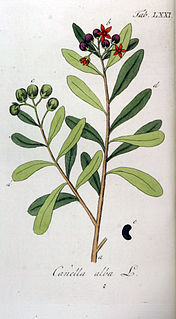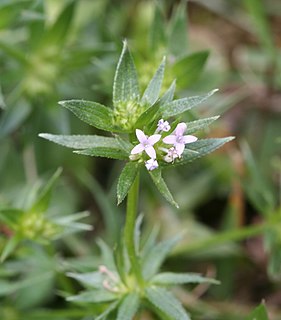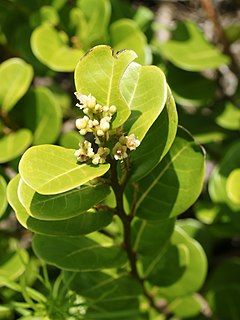
Elaeis is a genus of palms containing two species, called oil palms. They are used in commercial agriculture in the production of palm oil. The African oil palm Elaeis guineensis is the principal source of palm oil. It is native to west and southwest Africa, occurring between Angola and Gambia. The American oil palm Elaeis oleifera is native to tropical Central and South America, and is used locally for oil production.

The Canellaceae are a family of flowering plants in the order Canellales. The order includes only one other family, the Winteraceae. Canellaceae is native to the Afrotropical and Neotropical realms. They are small to medium trees, rarely shrubs, evergreen and aromatic. The flowers and fruit are often red.

Antidesma is a genus of tropical plant in the family Phyllanthaceae formally described by Linnaeus in 1753. It is native to tropical Africa, S + E + SE Asia, Australia, and various oceanic islands. The greatest diversity occurs in Southeast Asia.

Chrysophyllum is a group of trees in the Sapotaceae described as a genus by Linnaeus in 1753.

Manilkara is a genus of trees in the family Sapotaceae. They are widespread in tropical and semitropical locations, in Africa, Madagascar, Asia, Australia, and Latin America, as well as various islands in the Pacific and in the Caribbean. A close relative is the genus Pouteria.

Carissa is a genus of shrubs or small trees native to tropical and subtropical regions of Africa, Australia and Asia. Until recently about 100 species were listed, but most of them have been relegated to the status of synonyms or assigned to other genera, such as Acokanthera.

Syzygium cumini, commonly known as Malabar plum, Java plum, black plum, jamun or jambolan, is an evergreen tropical tree in the flowering plant family Myrtaceae, and favored for its fruit, timber, and ornamental value. It is native to the Indian Subcontinent, adjoining regions of Southeast Asia, including Myanmar, Sri Lanka, and the Andaman Islands. It can reach heights of up to 30 metres (98 ft) and can live more than 100 years. A rapidly growing plant, it is considered an invasive species in many world regions.

Sherardia is a monotypic genus of flowering plants in the family Rubiaceae. The genus contains only one species, viz. Sherardia arvensis or (blue) field madder, which is widespread across most of Europe and northern Africa as well as southwest and central Asia and Macaronesia. It is also reportedly naturalized in Australia, New Zealand, Taiwan, Kerguelen, Ethiopia, Sudan, southern Africa, Mexico, Costa Rica, South America, Bermuda, Cuba, Haiti and much of Canada and the United States.

Chrysobalanus icaco, the cocoplum, paradise plum, abajeru or icaco, is found near sea beaches and inland throughout tropical Africa, tropical Americas and the Caribbean, and in southern Florida and the Bahamas. It is also found as an exotic species on other tropical islands, where it has become a problematic invasive. Although taxonomists disagree on whether Chrysobalanus icaco has multiple subspecies or varieties, it is recognized as having two ecotypes, described as an inland, much less salt-tolerant, and more upright C. icaco var. pellocarpus and a coastal C. icaco var. icaco. Both the ripe fruit of C. icaco, and the seed inside the ridged shell it contains, are considered edible.

Dioscorea bulbifera is a species of true yam in the yam family, Dioscoreaceae. It is native to Africa, Asia and northern Australia. It is widely cultivated and has become naturalized in many regions.

Vitex is a genus of flowering plants in the sage family Lamiaceae. It has about 250 species. Common names include chaste tree or chastetree, traditionally referring to V. agnus-castus but often applied to other species as well.

Carissa spinarum, the conkerberry or bush plum, is a large shrub of the dogbane family (Apocynaceae), widely distributed in tropical regions of Africa, Southern Asia, Australia, and various islands of the Indian Ocean. It is most well known in Australia, where it is also called currant bush or, more ambiguously, native currant or even black currant. It is, however, neither closely related to plums (Prunus) nor to true currants (Ribes), which belong to entirely different lineages of eudicots. In India, it is also called wild karanda /wild karavanda, referring to the related karanda. Carissa spinarum is often discussed under its many obsolete synonyms.

Galium boreale or northern bedstraw is a plant species of the Rubiaceae. It is widespread over the temperate and subarctic regions of Europe, Asia and North America including most of Canada and the northern United States.

Mimusops is a genus of plants in the family Sapotaceae described as a genus by Linnaeus in 1753.

Cyperus odoratus is a species of sedge known by the common names fragrant flatsedge and rusty flatsedge. This plant can be found in much of the tropical and warm temperate world, including South, Central, and North America, Southeast Asia, some Pacific Islands, Australia, New Guinea, Madagascar, and central Africa. It is a plant of wet, muddy areas, including disturbed and altered sites. This species is quite variable and may in fact be more than one species included under one name. In general this is an annual plant approaching half a meter in height on average but known to grow much taller. It usually has some long, thin leaves around the base. The inflorescence is made up of one to several cylindrical spikes attached at a common point. Each of the spikes bears a large number of flat, oval-shaped spikelets. Each spikelet is usually light brown to reddish-brown and has a few to over 20 flowers. Each flower is covered by a tough, flat bract with a visible midvein. The fruit is a flat achene less than two millimeters long.

Guettarda speciosa, with common names sea randa, or zebra wood, is a species of shrub in the family Rubiaceae found in coastal habitats in tropical areas around the Pacific Ocean, including the coastline of central and northern Queensland and Northern Territory in Australia, and Pacific Islands, including Micronesia, French Polynesia and Fiji, Malaysia and Indonesia, Maldives and the east coast of Africa. It reaches 6 m in height, has fragrant white flowers, and large green prominently-veined leaves. It grows in sand above the high tide mark.

Ammocharis longifolia is a species of bulbous plant in the family Amaryllidaceae. It has been placed as the only species, Cybistetes longifolia, in the monotypic genus Cybistetes.

Zephyranthes atamasca, commonly known as the atamasco-lily or more generally a rain-lily, is native to the southeastern United States. It grows in swampy forests and coastal prairies, preferring acid boggy soils rich with leaf mold. Following the appearance of broad, grassy leaves in early winter, it blooms in March or April. It has several narrow, linear basal leaves about 0.5 in (13 mm) wide and 10–15 in (25–38 cm) long. Its native range extends from Florida north to Maryland and west to Mississippi. The species is also naturalized in Bermuda and in the Mariana Islands. Both its leaves and bulbs are poisonous.

Leucojum vernum, called spring snowflake, is a perennial bulbous flowering plant species in the family Amaryllidaceae that includes the onions, daffodils and Agapanthus. It is native to central and southern Europe from Belgium to Ukraine. It is considered naturalized in north-western Europe, including Great Britain and parts of Scandinavia, and in the US states of Georgia and Florida. It is cultivated as a spring-flowering ornamental bulbous plant. Usually a single white flower with greenish marks near the tip of each tepal is borne on a stem about 10–20 cm tall, occasionally more.

Scaevola plumieri is a species of plant in the family Goodeniaceae which grows on coastal dunes in the tropics and subtropics.




















